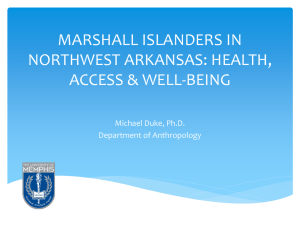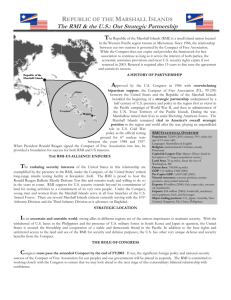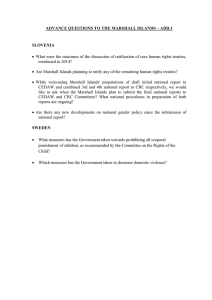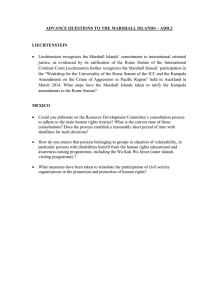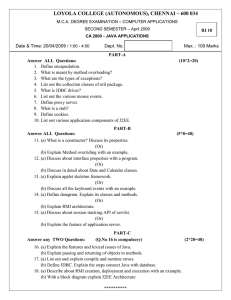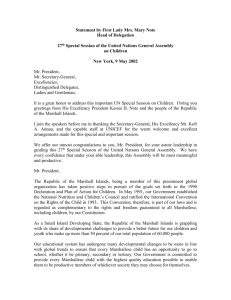Republic of the Marshall Islands
advertisement
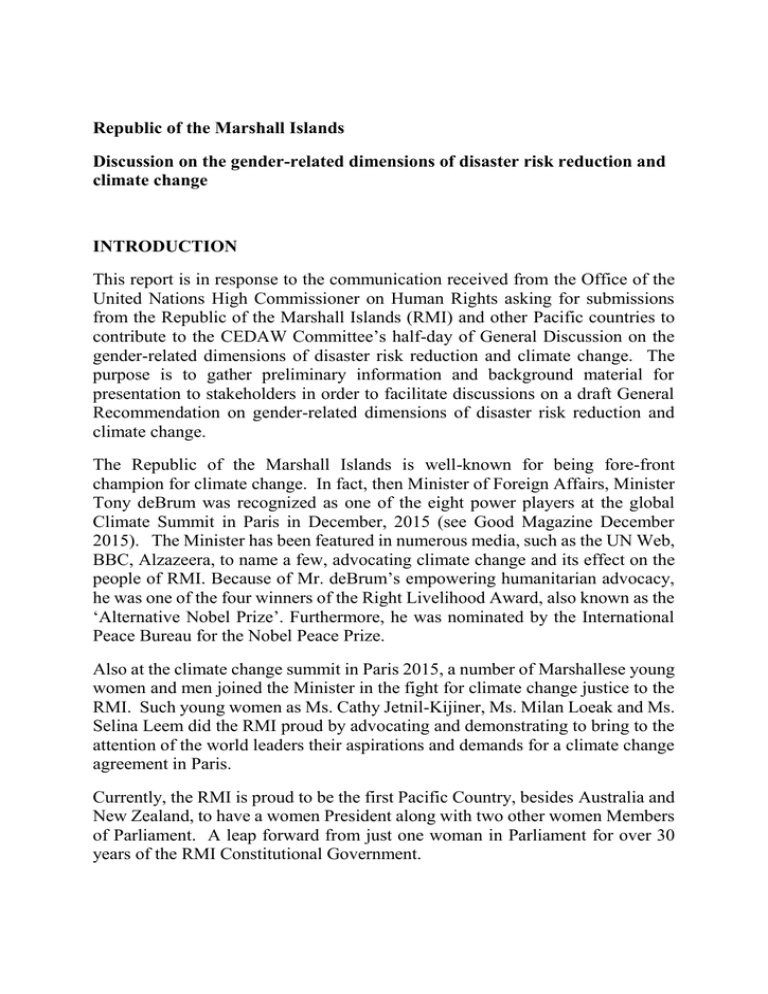
Republic of the Marshall Islands Discussion on the gender-related dimensions of disaster risk reduction and climate change INTRODUCTION This report is in response to the communication received from the Office of the United Nations High Commissioner on Human Rights asking for submissions from the Republic of the Marshall Islands (RMI) and other Pacific countries to contribute to the CEDAW Committee’s half-day of General Discussion on the gender-related dimensions of disaster risk reduction and climate change. The purpose is to gather preliminary information and background material for presentation to stakeholders in order to facilitate discussions on a draft General Recommendation on gender-related dimensions of disaster risk reduction and climate change. The Republic of the Marshall Islands is well-known for being fore-front champion for climate change. In fact, then Minister of Foreign Affairs, Minister Tony deBrum was recognized as one of the eight power players at the global Climate Summit in Paris in December, 2015 (see Good Magazine December 2015). The Minister has been featured in numerous media, such as the UN Web, BBC, Alzazeera, to name a few, advocating climate change and its effect on the people of RMI. Because of Mr. deBrum’s empowering humanitarian advocacy, he was one of the four winners of the Right Livelihood Award, also known as the ‘Alternative Nobel Prize’. Furthermore, he was nominated by the International Peace Bureau for the Nobel Peace Prize. Also at the climate change summit in Paris 2015, a number of Marshallese young women and men joined the Minister in the fight for climate change justice to the RMI. Such young women as Ms. Cathy Jetnil-Kijiner, Ms. Milan Loeak and Ms. Selina Leem did the RMI proud by advocating and demonstrating to bring to the attention of the world leaders their aspirations and demands for a climate change agreement in Paris. Currently, the RMI is proud to be the first Pacific Country, besides Australia and New Zealand, to have a women President along with two other women Members of Parliament. A leap forward from just one woman in Parliament for over 30 years of the RMI Constitutional Government. I. THE PEOPLE AND THE LAND The Marshall Islands lies between 4 degrees and 15 degrees north latitude and between 160 degrees and 173 degrees east longitude, 2,270 miles south-west of Hawaii and 1,500 miles east of Guam. The nation comprises 29 coral atolls and five reef islands scattered over 750,000 square miles of the central Pacific Ocean. Twenty of the atolls and four of the single islands are inhabited. These islands and atolls are arrayed in two parallel chains, the Ratak (sunrise) chain to the east and the Ralik (sunset) chain to the west. The total land area of the nation is only 70.05 square miles. Each atoll consists of a ring of islets encircling a deep-water lagoon. The islets are interconnected and surrounded by a coral reef. None of these low-lying land areas has an elevation greater than 10 feet above sea level. The mean height of the land is about 7 feet above sea level. Source: ©SPC, 2013. Traditionally, Marshallese live in extended matrilineal family groups of three or more generations. According to the 2011 RMI Census, the Marshall Islands has a total estimated population of 53,158. The average household size of 6.8 people. Each person belongs to his or her mother's bwij, or lineage, and has the right to use lineage land and other property. These lineage groups own most of the land in the Marshall Islands, which can only be owned by citizens. Marshallese society is also divided into two hereditary classes: the iroij, the nobility, and the dri jerbal, the workers who are the kajur, or strength of the iroij. Both classes have clan rights to live and work on land. While the workers are expected to respect the nobles and pay them tribute from the fruits of their labour, the nobles are expected to assist their people in times of need and to resolve disputes. As the Marshall Islands moved from a subsistence economy to a mixed cash/subsistence economy, the observance of the traditional social structure has diminished. Rather than living and working on the wife's land with her extended family, nuclear families migrate to Majuro and Ebeye (the urban centres) for cash jobs. Also, a new elite has emerged. Some untitled business people have more wealth and influence than some traditional chiefs, as do certain political leaders with control over government funds. However, the wealthy iroijes still command the greatest respect, and some are elected leaders. II. GOVERNMENT On 1 May 1979, the nation became internally self-governing after adopting a constitution drafted by elected representatives. The Constitution of the Marshall Islands incorporates a blend of the British and American constitutional concepts and consists of legislative, executive, and judicial branches. The legislature is a bicameral institution consisting of the Council of Iroij and the Nitijela. The main function of the Council of Iroij, which has a membership of 12, is to request consideration by the Nitijela of bills affecting customary law, land tenure, or any traditional practice. The Nitijela is the lawmaking chamber and consists of 33 members who stand for election every four years. The Nitijela also elects from its ranks a president and, on nomination by the President, other members of the Nitijela to serve with the President as the Cabinet. The Cabinet is the executive branch of the Government and directs the actions of the Public Service. The Cabinet is answerable to the Nitijela for its actions. The judicial branch consists of a supreme court, a high court, a traditional rights court and community courts. At the municipal level, each atoll has a local government comprised of an elected Mayor and Council. There are 24 local governments that govern the affairs of the atolls and islands. Each local government consists of an elected council (except Ebon Atoll which has an hereditary council), an elected mayor, appointed or elected local officials, and a local police force. United States Trusteeship administration of the Marshall Islands came to an end on 21 October 1986, when the Compact of Free Association between the Government of the United States and the Government of the Marshall Islands came into effect. Under free association, the Marshall Islands is self governing under its own Constitution and conducts its own domestic and foreign affairs, while the United States Government has authority and responsibility for defence and security matters. In September 1991, the Republic of the Marshall Islands became a member of the United Nations. III. CLIMATE The islands have a hot and humid climate. The average annual temperature is 81 degrees Fahrenheit with little seasonal variation. Trade winds from the north-east cool the high temperatures from December through March. The average annual rainfall varies from 70 inches in the north of the nation to 170 inches in the south. The wettest months of the year are October and November, and the months from December to April are generally drier. The Republic is not considered to be in the typhoon belt. Nevertheless, because the island groups are true atolls with low-lying reefs and land masses, they are easily flooded during storms and tidal surges. In 1958, a typhoon destroyed buildings and structures in the old capital at Jabwor on Jaluit Atoll. In 1979, a series of tidal surges struck the most heavily populated areas of Majuro Atoll over a two-week period, destroying hundreds of homes and causing several million dollars in damage. The table below shows recent past disaster events affecting the RMI. Year Event Areas Affected 2016 2013 Drought Drought 2013 2008 Sea swell, King Tide Sea swell, King Tide 2008 2007 State of Economic Emergency Severe Drought ?????? 15 atolls/islands north of Majuro (above 8°N latitude) Majuro Numerous Pacific locations including the RMI All of RMI 1998 1997 Severe Drought Typhoon Paka Majuro, Utrik, Wotho, Lae, Namu, Ailuk All of RMI Majuro, Aillinglapalap, Namu 1994 1992 1992 1991 1988 1979 High Surf Wave Action Typhoon Gay Tropical Storm Axel Typhoon Zelda Tropical Storm Roy Sea swell Ajeltake Majit All of RMI All of RMI Kwajalein Majuro IV. NATIONAL POLICIES, PLANS AND MEASURES AND GENDERRELATED DIMENSIONS TO DISASTER RISK AND CLIMATE CHANGE RMI has several policies and plans relating to climate change. In addition to Vision 2018, there is the Climate Change Roadmap 2010, the 2011 National Climate Change Policy Framework (NCCPF), the Natioinal Strategic Plan 20152017 and the Joint National Action Plan for Climate Change Adaptation and Disaster Risk Management 2014-2018 (JNAP), amongst others. The National Strategic Plan (NSP) was developed in 2013 through a collaborative process led by EPPSO under the guidance and advice of the NSP Steering Committee established by Cabinet and chaired by the Chief Secretary. The NSP was “designed as a framework to coordinate the articulated medium term development goals and objectives of the RMI government at the national level.” It covers a three year increment period, starting 2015-2017 and will continually updated in order to meet longer term objectives, especially in regards towards the scheduled completion of The Compact of Free Association, as Amended funding in 2023. The NSP was developed in line with both The Constitution and Vision 2018. The objective of the NSP is “Sustainable, equitable and measurable development reflecting the priorities and culture of the Marshallese People.” This objective will be achieved through activities in five sectors: Social Development, Environment, Climate Change and Resiliency, Infrastructure Development, Sustainable Economic Development, and Good Governance. The objectives that come under each sector are aligned with ten national development themes derived from Vision 2018. The National Climate Change Policy Framework (NCCPF) presents five strategic goals that aim to provide a pathway to an integrated, whole-of-RMI response. Objectives and outcomes are identified for each goal. One of the goals: Building education and awareness, community mobilisation, whilst being mindful of culture, gender and youth. More recently, and in recognition of the need for integration of climate change into development planning, the National Climate Change Committee developed the Joint National Action Plan on Climate Change Adaptation and Disaster Risk Management (JNAP) for RMI. RMI’s JNAP provides a roadmap for building a resilient country. The JNAP also helps to provide a more co-ordinated approach to dealing with disaster risk reduction and climate change issues by all agencies. It provides a detailed strategy for “holistically and co-operatively addressing risk in the RMI. The JNAP’s goals include: establishing and supporting an enabling environment for improved coordination of disaster risk management/climate change adaptation in the RMI, public education and awareness of effective Climate Change Adaptation and Disaster Risk Management from local to national level, enhanced emergency preparedness and response at all levels within the RMI, improved energy security while working towards a low carbon future for the RMI, enhanced local livelihoods and community resilience for all people of the RMI, and an integrated approach to development planning including consideration of climate change and disaster risks. The RMI National Gender Policy 2014 was developed in line with Convention on the Elimination of All Forms of Discrimination against Women (CEDAW), Convention on the Rights of the Child (CRC), the Pacific Plan, the Millennium Development Goals (MDG), the Beijing Platform for Action, the Revised Pacific Platform for Action for the Advancement of Women and Gender Equality and the 2012 Pacific Islands Forum Leaders’ Gender Equality Declaration. The purpose of the National Gender Equality Policy is to guide the process of developing laws, policies, procedures and practices that will address the needs, priorities and aspirations of all women and men and effectively eliminate all forms of discrimination and inequality. It concerns private and public sectors, local governments, and communities. It requires the mainstreaming of gender perspective across all governments policies, strategies, programs and services. The Policy Stratetic Plan of Action 2015-2019 describes outputs, key actions, and sectors concerned for the achievement of the outcomes of the National Gender Policy. The implementation of the policy requires the active involvement and contribution of the Council of Iroj, the Nitijela, all Government sectors, civil society organizations and communities. The five strategic areas are intended to be coordinated and work with national policies and ongoing and/or planned strategic plans in the RMI government ministries, agencies and SOEs. IV. GENERAL LEGAL FRAMEWORK WITHIN WHICH HUMAN RIGHTS ARE PROTECTED In the Marshall Islands, human rights are enumerated and guaranteed under article II of the Constitution, the Bill of Rights. These rights include, amongst other, (a) equal protection and freedom from discrimination; (b) personal autonomy and privacy; (c) access to health, education and legal services; (d) ethical government; and (e) any other rights retained by the people. The Republic's High Court and the Supreme Court have jurisdiction to hear cases involving human rights. Normally, the High Court exercises original jurisdiction and the Supreme Court appellate jurisdiction. However, the High Court may, if it so chooses, remove cases to the Supreme Court that raise questions as to the interpretation or effect of the Constitution. In such removed cases, the Supreme Court exercises original jurisdiction. RMI has ratified the following United Nations Conventions: 1. Convention on the Rights of the Child (CRC)– 1998 2. Convention on the Elimination of the all Discrimination against Women (CEDAW) – 2006 3. Convention on the Rights of Persons with Disabilities (CRPD) – 2015 The RMI also passed into law: Human Rights Committee Act in 2015, to (a) establish a multi stakeholder body to promote the human rights standards, including living in the Marshall Islands; (b) promote the implementation of international human rights standards, including international human rights treaties to which the Marshall Islands is a State Party; (c) promote an inclusive and coordinated cross-sectoral approach to implementation of human rights reporting and programs; (d) promote understanding of and compliance with the Bill of Rights and legislation promoting human rights; (e) establish a complaints mechanism for the redress of human rights violations. Domestic Violence Protection Prevention Act 2011 Child Protection Act 2015, and Rights of Persons with Disabilities Act 2015; and to establish a complaints mechanism for the redress of human rights violations. V. ONGOING CHALLENGES Although involved in climate change adaptation efforts since the early 2000s, a national climate change framework in 2010, the JNAP, the NSP, the Gender Policy and other measures domestically and internationally, the Marshall Islands has a low level of implementation of individual adaptation projects. There is a need to improve level of understanding towards gender dimensions of risk reduction. Often times, it a challenge to address the issue itself because the people don’t have a clear understanding of what they’re referring to, this comes down to the fact that not many understand ‘gender’, it is always a challenge because people usually mistaken the word itself with ‘women’. In addition, there is not much political and financial commitment seen on ground. The RMI has made progress in putting more women in policy making positions, with the first women head of state and three women members of parliament, as evidenced by the foregoing, not much has been put into national policies to include gender-related dimensions in policy making, particularly, disaster risk and climate change. It just recently been specifically looking at the gender dimensions of climate change through an on-going project and RMI National Climate Change Roadmap 2010. Although, traditionally, Marshall Islands is of matrilineal culture and women have been decision-makers and owners of land resources and there is recognition of their significant contributions to the peaceful development and wellbeing of our families, community and to our society as a whole. The strength of our traditional beliefs has not eliminated a tendency to stereotype gender roles. Stereotypes that continue to affect our understanding of gender roles include the belief that the place of a woman is in the home while men should occupy the public space and be the breadwinner. Additionally, positions of leadership and decision-making are regarded as male roles. Today, in a changing world where women are educated as well as men, where families need more resources to fulfill their needs and women are increasingly contributing to their families’ incomes, and where we need to face growing environmental threats, we cannot afford to limit the contribution of women in the development of our country and contributing to disaster risk and climate change issues, particularly, issues with respect to women and climate change. Fundamental values of our culture include caring for each other, respect, and partnership. These are required to address the imbalance we see today between women and men and to eliminate discriminations. Applying these values will help us ensure that the fundamental human rights of women and men are respected and that all women and men have equal opportunities and share the benefits of development. CONCLUSION The Republic of the Marshall Islands is familiarized with the many effects of climate change and natural disasters due to its geographical position. This can be seen as a motivation for the government and its people to adopt measures in preparation for the challenges to be dealt with. With today’s changing world perspective, people are more educated, new technologies are emerging, and small island countries have formed alliances with the purpose of coming up with solutions for the ongoing problems of climate change and disasters. The disastrous events that affected the RMI over the years has made the government of the Marshall Island and its people to be some of the active key players for climate justice globally as well as addressing the effects of man-made and natural disasters. In addition, when RMI ratified CEDAW, there are improvements that can be in decision making level which coincides with the fact that more women are elected to the parliament and more are within the decision making level which will make it easy to address the subject itself and to involve the challenges that are often times not taken into account. Furthermore, the government has been actively adopting national policy plans and measures & gender related dimensions on climate change and disaster. Although RMI has taken measures for the issue itself, there is still a need to address the gaps. Gender issues should no longer be separated and supported by a few from the working level. There is a need to improve capacity building to implement action plans. Full commitment from the ‘higher ups’ is yet to be achieved. Nevertheless, the government is already working towards making improvements on every level to change the perspective of many that gender issues are just as important as any other issues elsewhere and especially in the republic.
